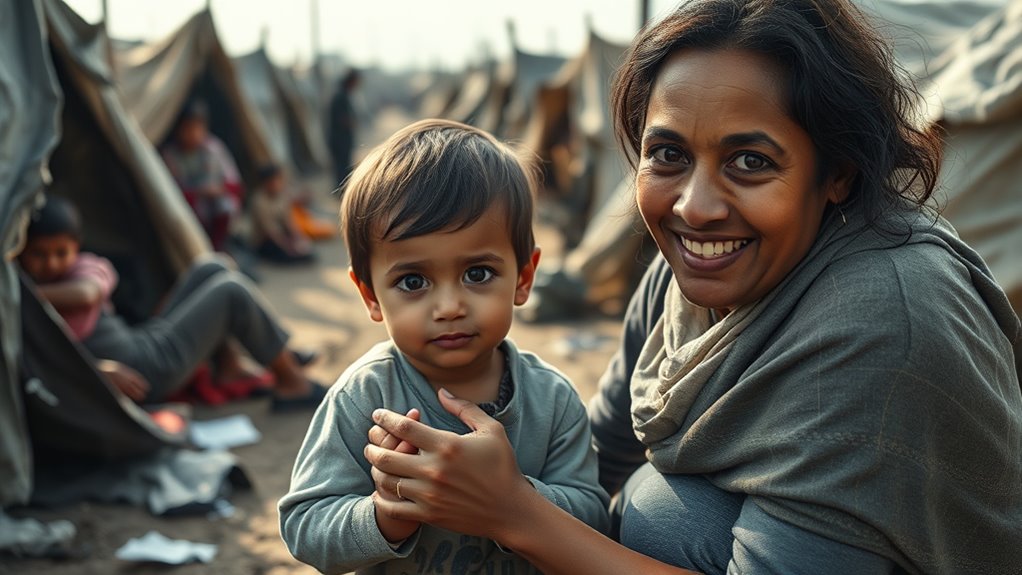To support children in disaster scenarios, focus on recognizing their emotional and behavioral signs of distress, like withdrawal or outbursts, and respond with age-appropriate communication. Create a safe, predictable environment with routines, clear boundaries, and truthful information. Encourage play, art, and storytelling to foster resilience, while limiting media exposure that could increase anxiety. Connecting children with trusted support networks and professional help further aids recovery. If you keep exploring, you’ll discover more ways to help them heal.
Key Takeaways
- Recognize and respond to children’s emotional and behavioral signs of distress with age-appropriate communication and coping techniques.
- Create a safe, stable environment through routines, boundaries, and community support to reduce anxiety.
- Ensure safe, honest communication channels while monitoring media exposure to prevent fear and misinformation.
- Promote emotional resilience using relaxation, mindfulness, and peer support activities.
- Engage community leaders and mental health professionals to provide long-term support and reduce stigma.
Recognizing Signs of Distress in Children

Children often display their distress through changes in behavior or emotions, especially during or after a disaster. You should watch for emotional triggers that seem to spark sudden outbursts, withdrawal, or fear. Behavioral cues can include clinginess, trouble sleeping, or regression to earlier behaviors like thumb-sucking. Notice if your child becomes unusually quiet or irritable, or if they lose interest in activities they once enjoyed. These signs are your clues that your child might be overwhelmed or anxious. Recognizing these early warning signals allows you to respond promptly and compassionately. By paying close attention to emotional triggers and behavioral cues, you can better support your child’s emotional needs during difficult times. Understanding child psychology can help you interpret their reactions more effectively. Additionally, being aware of disaster-related stress can help you identify specific anxieties related to their environment or experiences. Developing emotional resilience in children can also aid in their recovery and coping skills after traumatic events. Recognizing early warning signs enables caregivers to seek appropriate support and intervention when necessary.
Creating a Safe and Stable Environment
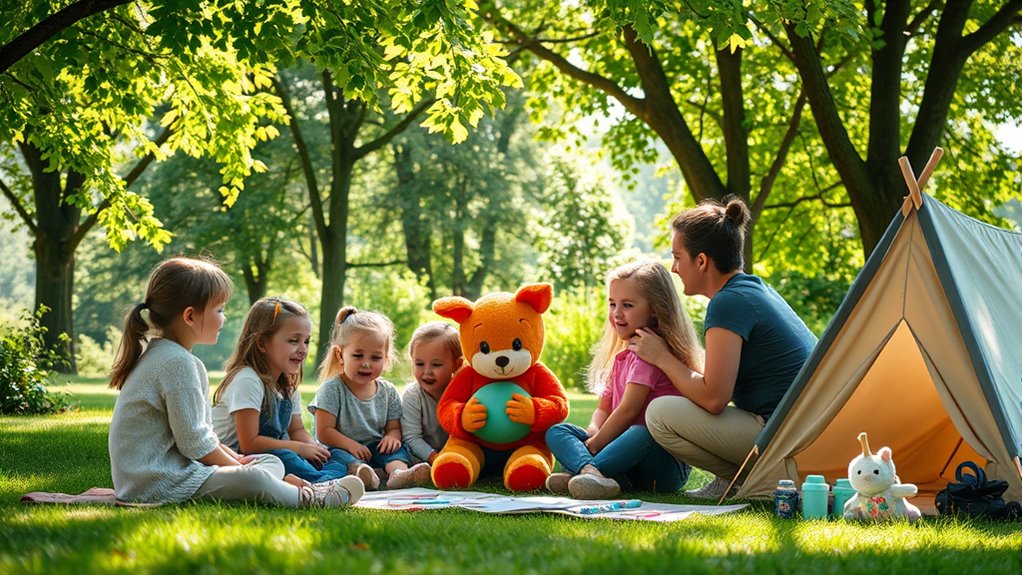
Establishing consistent routines and clear boundaries helps children feel secure during chaos. Make sure communication channels are safe and accessible so they can share their feelings without fear. These steps create a stable environment that supports their emotional well-being in tough times. Incorporating fabric decorating markers and reliable communication tools ensures that children receive accurate information and support when needed. Understanding anime movies can also provide comfort and a sense of normalcy, helping children process their emotions during stressful situations. Using well-draining soil techniques for any outdoor activities can also foster a sense of control and nurturing, which is beneficial for their mental health. Additionally, fostering a sense of community support can significantly enhance their resilience and emotional stability during disasters.
Consistent Routines and Boundaries
When chaos surrounds them, maintaining consistent routines and clear boundaries becomes essential for creating a sense of safety and stability. Kids thrive on predictability, especially during disasters. Establishing daily schedules helps them feel more in control and reduces anxiety. Clear family boundaries reinforce safety and consistency, showing children what’s expected and what’s not. Incorporating familiar decor elements from their home environment can also provide comfort and familiarity amidst turmoil. Consistent communication about family routines helps children understand what to expect next, further easing their anxiety. Recognizing relationship dynamics can help parents address emotional needs and foster security during challenging times. Understanding routine management strategies can also support children in adapting more effectively to sudden changes. Additionally, leveraging automation in business concepts like streamlined processes can inspire creative ways to implement routines efficiently at home.
Safe Communication Channels
Maintaining consistent routines and boundaries helps children feel secure, but it’s equally important to guarantee they have reliable ways to communicate during chaos. Establishing safe communication channels allows children to reach out, seek support, and share their feelings. Encourage peer support by helping children connect with trusted friends or family through verified digital platforms. To ensure digital safety, set clear rules on device use, monitor online interactions, and use secure apps that protect privacy. Teach children how to recognize trustworthy contacts and avoid sharing personal information online. Regular check-ins, both in person and via secure digital means, help children feel connected and supported. Additionally, providing children with proper devices and teaching them how to use communication tools responsibly can significantly enhance their sense of security. Being aware of available support hours ensures that help is accessible when needed. It is also helpful to educate children about narcissistic manipulation tactics, so they can better identify and protect themselves from potential emotional manipulation. Creating these safe channels fosters stability, reassures children, and empowers them to express their needs during stressful times.
Encouraging Open Communication and Expression
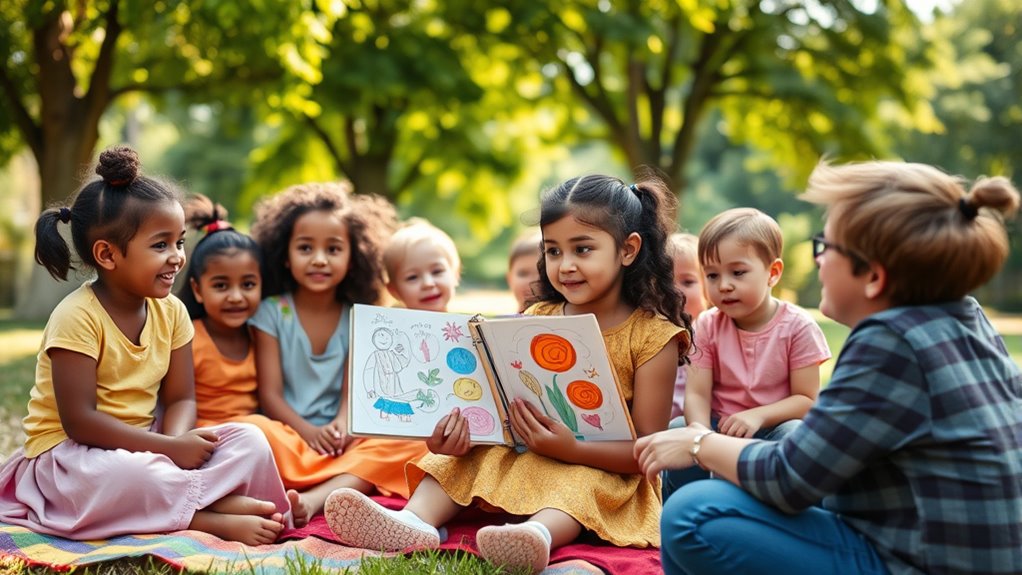
Creating a safe space encourages children to share their feelings openly without fear. Use language appropriate for their age to help them understand and express themselves clearly. When you foster these environments, kids feel more comfortable opening up about their experiences. Recognizing emotional expression in their expressions can further aid in understanding their emotional state. Incorporating mindfulness practices, such as deep breathing or visualizations, can also support children in managing their feelings effectively. Additionally, understanding the importance of juice cleansing and detox can serve as a metaphor for helping children “detox” from overwhelming emotions and regain balance. Being attentive to their emotional needs ensures that caregivers can provide targeted support and reassurance during challenging times, especially considering that resources and tools are vital for effective emotional support.
Foster Safe Spaces
Fostering safe spaces is essential for helping children process their emotions during disaster scenarios. When children feel secure, they’re more likely to open up and share their feelings. Incorporate play therapy to create an environment where children can express themselves through creative activities, making complex emotions more manageable. Peer support also plays a vital role; encouraging children to connect with friends fosters trust and reduces feelings of isolation. By establishing a space free of judgment, you help children feel heard and understood. Remember, a safe space isn’t just physical—it’s emotional too. When children sense that their feelings are valid and accepted, they build resilience and can better cope with the ongoing challenges of a disaster scenario. Additionally, understanding the importance of safe spaces in the context of emotional well-being can significantly enhance their coping strategies. Creating an environment that promotes emotional safety allows children to develop coping skills essential for recovery and resilience in the face of adversity. Recognizing the role of skincare patches in emotional regulation can also be beneficial; just as they promote physical healing, creating moments of comfort and care can support children’s emotional healing.
Use Age-Appropriate Language
Using age-appropriate language is essential for helping children feel comfortable sharing their thoughts and feelings during a disaster. When you speak in simple, clear terms, children can better understand their emotions and develop emotional regulation skills. Avoid complex explanations that might cause confusion or fear. Encourage open communication by asking questions suited to their age and listening without judgment. This helps children express themselves honestly and reduces anxiety. Also, promote peer support by creating opportunities for children to talk and listen to each other in language they understand. When children feel heard and supported, they’re more likely to manage their emotions effectively and feel less isolated during stressful events. Clear, age-appropriate language builds trust and fosters resilience in young disaster survivors.
Establishing Routine and Consistency
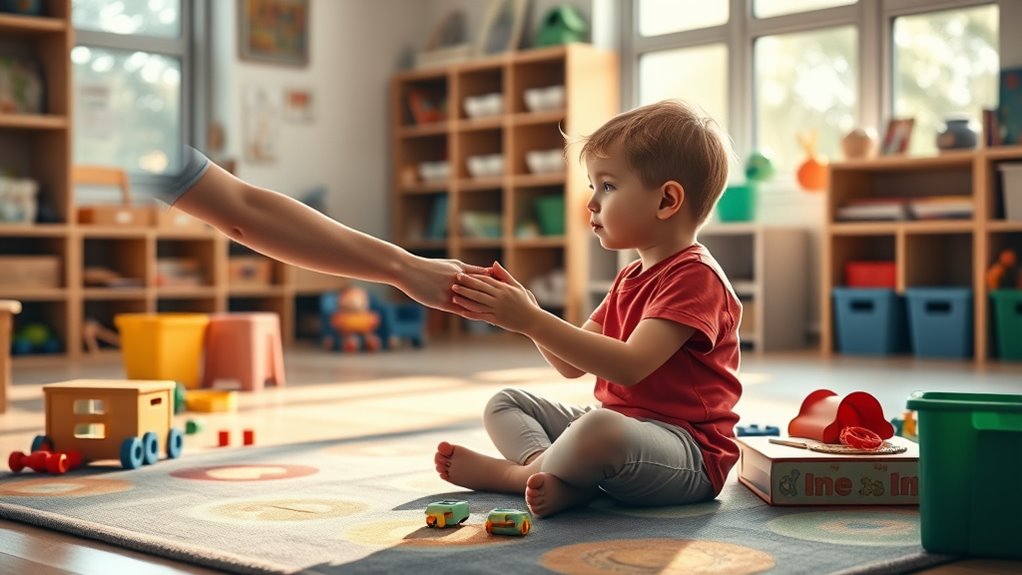
When children face disaster scenarios, maintaining a consistent daily routine can provide them with a sense of security and stability. A predictable schedule helps children feel more in control, which supports emotional regulation during stressful times. When routines stay steady, behavioral consistency improves, making it easier for children to manage their reactions and reduce anxiety. Clear daily patterns, such as regular mealtimes, bedtime, and activities, create a safe environment amid chaos. You can also incorporate simple rituals to reinforce stability, helping children feel grounded. Consistency reassures children that, despite the turmoil, some aspects of their lives remain familiar. This stability strengthens their resilience and promotes healthy emotional responses, making it easier for them to cope with the ongoing challenges of a disaster scenario.
Providing Age-Appropriate Information About the Disaster
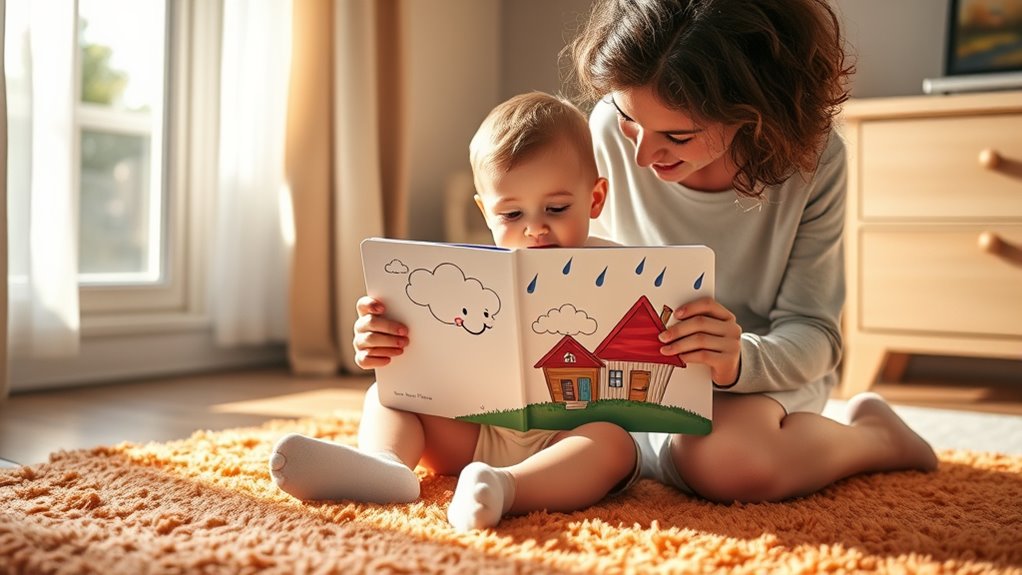
Providing age-appropriate information about the disaster helps children understand what’s happening without overwhelming them. Use child-focused communication to deliver messages suited to their developmental level. Age-sensitive messaging reassures children and reduces confusion or fear.
| Age Group | Key Message | Communication Tips |
|---|---|---|
| Preschool | Simple concepts, reassurance | Use calm tone, visuals |
| Early Elementary | Basic facts, honest but gentle | Short explanations, encourage questions |
| Older Children | Clear, truthful, but not detailed | Allow expression, avoid info overload |
| Preteens | More detailed, focus on safety | Respect their understanding, answer honestly |
| Teens | Honest info, discuss coping | Foster open dialogue, validate feelings |
Teaching Coping Skills and Relaxation Techniques
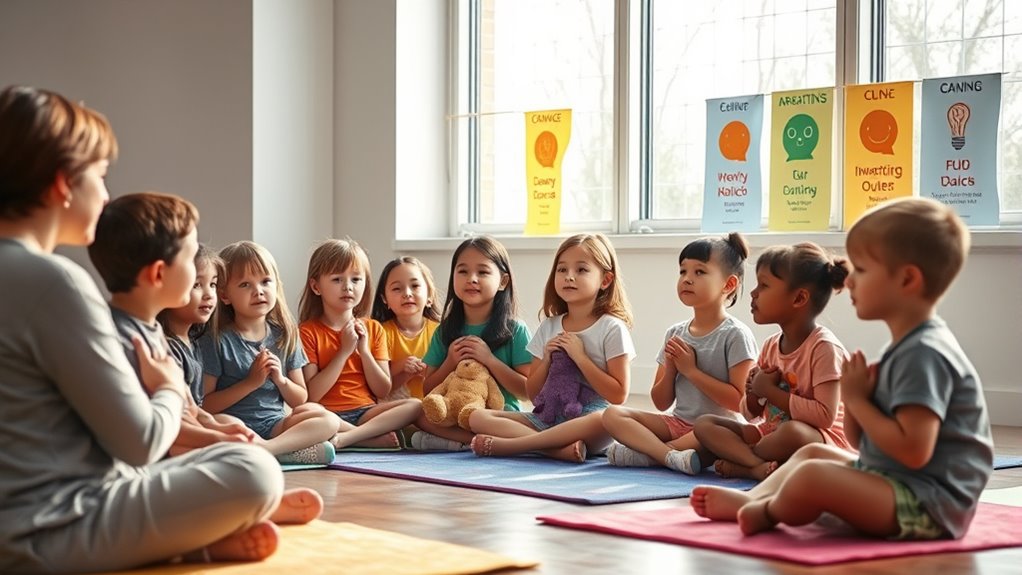
Teaching children coping skills and relaxation techniques helps them manage stress effectively. You can introduce simple breathing exercises, guided imagery, or establish consistent routines to promote stability. These strategies empower kids to find calm amid chaos and build resilience for future challenges.
Breathing Exercises for Calm
Breathing exercises are simple yet powerful tools that help children manage their emotions and find calm during stressful situations. By practicing mindful breathing, children learn to focus on each breath, which promotes relaxation and reduces anxiety. These calming techniques can be easily incorporated into daily routines or during moments of distress. To enhance effectiveness, encourage children to:
- Take slow, deep breaths through their nose, filling their lungs completely
- Focus on the sensation of air entering and leaving their body
- Count each breath to maintain attention and stay present
These simple steps help children develop resilience and emotional regulation skills. Consistent practice makes mindful breathing an accessible, effective strategy for calming the mind and body amid chaos.
Guided Imagery Practices
Guided imagery practices offer children a powerful way to relax and develop coping skills by mentally transporting them to calming and safe environments. Through visualization techniques, you help children create detailed mental images that evoke feelings of safety and tranquility. For example, you might guide them to picture a peaceful beach, a quiet forest, or a cozy room. As they focus on these images, their body responds with reduced stress and a calmer mind. This practice encourages children to access a sense of control during stressful times, helping them manage anxiety and fear. By regularly practicing guided imagery, children strengthen their ability to self-soothe and build resilience, making it easier for them to cope with the ongoing challenges of disaster scenarios.
Establishing Routine Stability
Establishing routine stability is essential during disaster scenarios because predictable daily activities help children feel secure and grounded. Consistent routines support emotional regulation by providing a sense of normalcy amidst chaos. Incorporate behavioral interventions to reinforce positive habits and reduce anxiety. You can:
- Create a predictable daily schedule to foster security
- Integrate calming activities like deep breathing or mindfulness exercises
- Establish consistent sleep and meal times to support emotional well-being
These steps help children manage their emotions effectively and build resilience. By maintaining routine stability, you help children develop coping skills and relaxation techniques that are crucial during stressful times. This structured environment encourages emotional regulation and minimizes behavioral challenges, promoting a sense of safety and control.
Supporting Emotional Resilience Through Play and Creativity
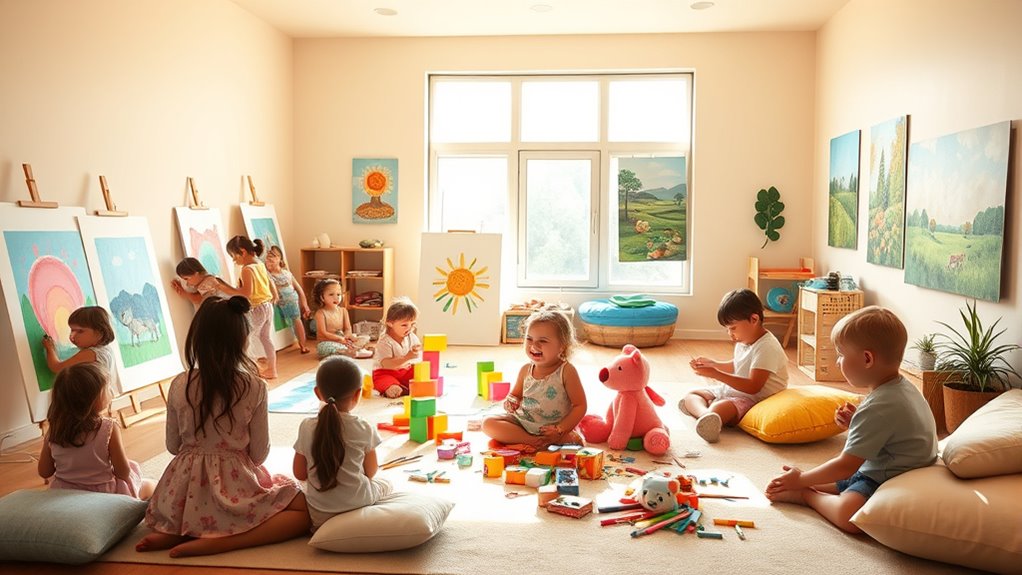
Engaging children in play and creative activities can considerably bolster their emotional resilience during disaster scenarios. Art therapy offers a safe outlet for children to express feelings they might not have words for, helping them process trauma indirectly through drawing, painting, or sculpting. Incorporating storytelling techniques allows children to externalize their experiences, making sense of difficult events and fostering emotional understanding. You can encourage children to create stories or pictures about their experiences, which helps reduce fear and anxiety. Playful activities also promote a sense of normalcy and control, essential during chaotic times. By integrating art therapy and storytelling into their routines, you enable children to build resilience, cope with stress, and recover emotionally more effectively.
Connecting Children With Support Networks and Professionals

Building on the emotional strength children develop through play and creative activities, connecting them with support networks and professionals provides an additional layer of stability and guidance. You can foster peer support by encouraging children to share their feelings and experiences with trusted friends, helping them feel less isolated. Community outreach programs serve as essential bridges, linking children to mental health professionals and resources that can address their specific needs. To strengthen this connection, consider:
Connecting children with support networks enhances resilience and promotes long-term mental well-being.
- Facilitating peer support groups to promote shared understanding and resilience
- Collaborating with local organizations to expand access to mental health services
- Engaging community leaders to reduce stigma and encourage help-seeking behaviors
These strategies help children build trust, access expert care, and develop a support system that promotes long-term mental well-being.
Monitoring and Managing Media Exposure

Children are especially vulnerable to the effects of distressing media content during disaster scenarios, making it essential to actively monitor and manage their media exposure. The media impact can amplify fear and anxiety, so setting clear exposure limits helps protect their mental health. You should supervise what children watch and discuss the content to guarantee it’s appropriate and not overwhelming. Limit their screen time with news and graphic coverage related to the disaster, especially during vulnerable times like bedtime or before school. Encourage children to engage in calming activities instead of constant media consumption. By controlling exposure, you reduce the risk of heightened stress and help them process the situation more healthily. Remember, managing media exposure is a critical step in supporting children’s emotional well-being during crises.
Promoting Self-Care and Care for Others
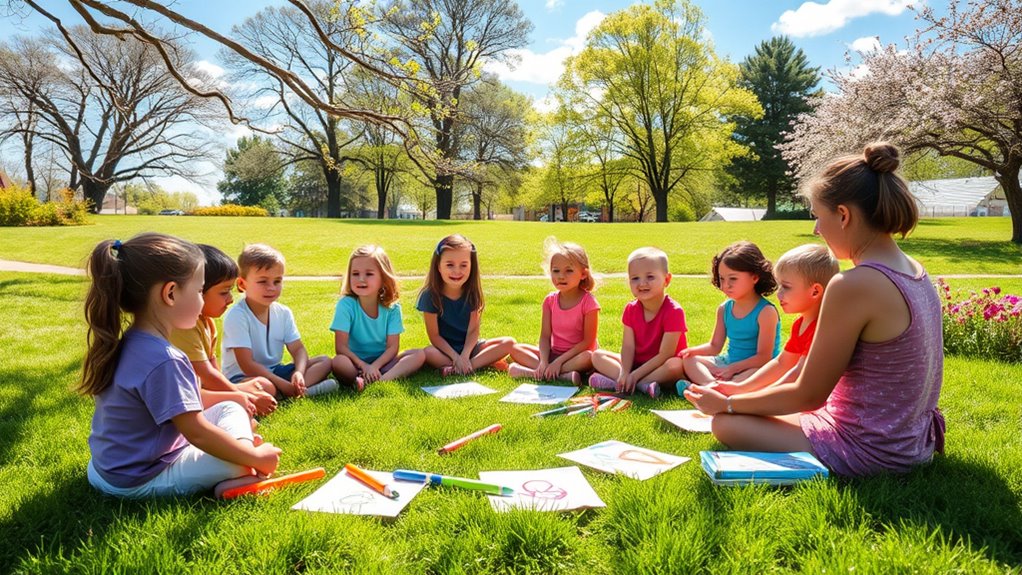
During disaster scenarios, encouraging self-care and caring for others helps children maintain their emotional resilience. You can teach them simple mindfulness exercises to help manage stress and stay grounded. Supporting peer support networks allows children to share feelings and foster connection. To promote these practices, consider:
- Encouraging regular mindfulness exercises like deep breathing or grounding techniques
- Facilitating peer support groups where children can openly discuss their concerns
- Reinforcing the importance of caring for others through small acts of kindness and empathy
Frequently Asked Questions
How Can Caregivers Manage Their Own Stress Around Children During Disasters?
You can manage your stress around children during disasters by practicing self-care techniques like deep breathing, regular breaks, and staying connected with support networks. Focus on emotional regulation by acknowledging your feelings without judgment and maintaining calmness. This helps you remain composed, providing a sense of stability for children. Remember, taking care of yourself isn’t selfish; it’s essential for effectively supporting your child’s emotional needs during challenging times.
What Are Signs of Trauma That Require Professional Intervention?
It’s no coincidence that recognizing signs of trauma is vital for seeking professional intervention. When children suddenly withdraw, display extreme fear, or revert to earlier behaviors, these are signs of trauma that need attention. If these signs persist or worsen, it’s essential to involve a mental health professional. Addressing these issues early helps children process their experiences, ensuring they get the support they need to heal and recover.
How Do Cultural Differences Influence Children’s Responses to Disasters?
You should recognize that cultural differences deeply influence how children respond to disasters. Cultural resilience shapes their coping mechanisms, guiding how they process trauma and seek support. Some cultures emphasize community and collective healing, while others focus on individual resilience. By understanding these cultural responses, you can better support children, respecting their unique coping strategies and fostering environments that enhance their natural resilience in the face of disaster.
What Resources Are Available for Ongoing Mental Health Support?
You can access a variety of resources for ongoing mental health support, such as online counseling, which offers flexible, confidential help from professionals. Peer support programs also play a crucial role, allowing children to connect with others who understand their experiences. These resources provide continuous assistance, helping children process their feelings and build resilience over time, especially during challenging times.
How Can Teachers Integrate Mental Health Strategies Into Classroom Settings?
Imagine a teacher implementing weekly mindfulness sessions, encouraging students to share feelings during class activities. You can promote peer support by creating group projects that foster collaboration and empathy. Incorporate regular check-ins to address emotional well-being. These strategies help children feel safe and understood, making the classroom a supportive environment. By actively integrating mental health practices into daily routines, you help students build resilience and emotional strength.
Conclusion
In the aftermath of a disaster, imagine your child’s bright smile flickering like a fragile flame. Your steady presence and gentle reassurance can help that flame grow stronger, illuminating their path to healing. By creating a safe space, encouraging open talk, and offering comfort through play, you become their anchor amid chaos. Your caring actions nurture resilience, helping them find hope and stability even in the darkest moments. Together, you can rebuild hope, one step at a time.

